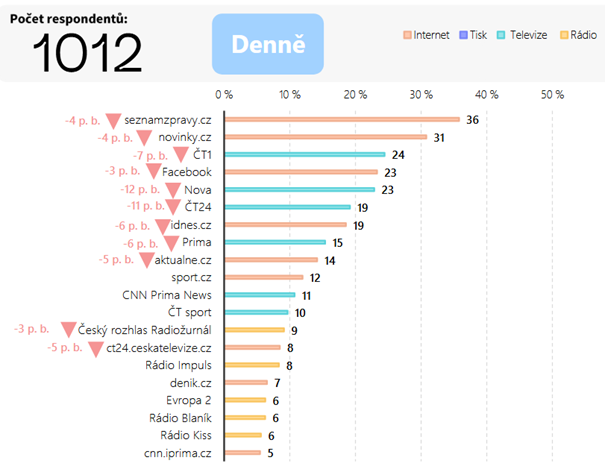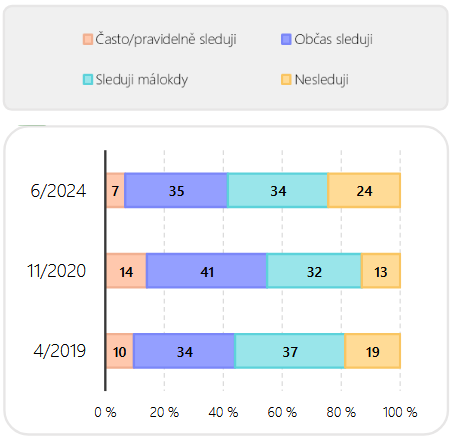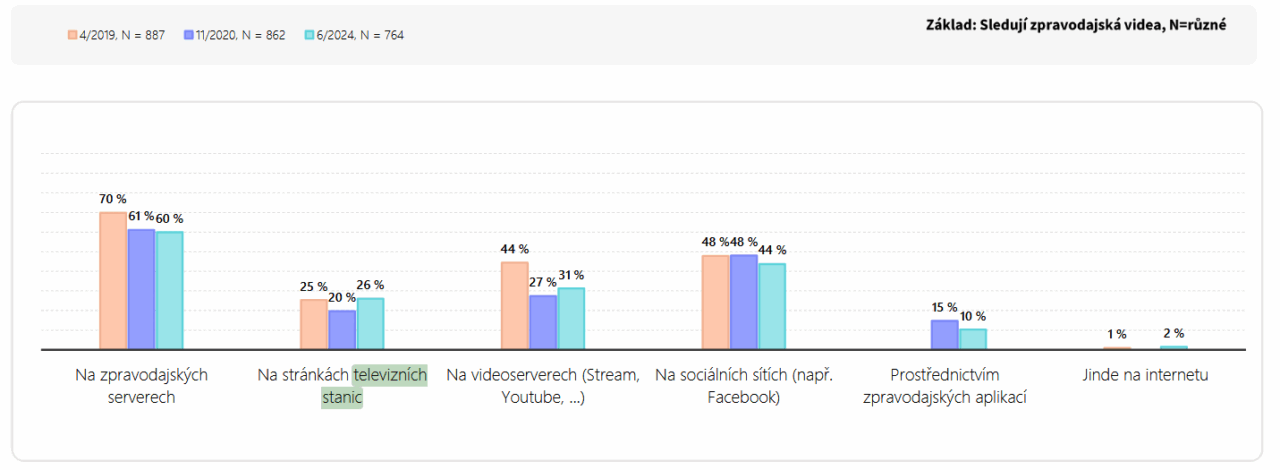Three-quarters of survey participants agree that watching the news helps them stay informed, take a broader view, and be engaged in society. In 2024, 49% of people watched television news daily, while in 2025, 4 out of 10 respondents report daily viewing. Compared to 2020, when just under two-thirds of people watched TV news daily, this represents a decline of 25 percentage points. The reason behind this is the widespread trend of media and news consumption fragmentation.
Daily news viewers are predominantly older adults
One of the changes is that people are shifting toward less frequent viewing, meaning the proportion of those who watch television news once a week or less has increased. Daily consumption of television news is more common among older viewers.
Daily TV news consumption by age and education
 Source: News in the Age of Media Fragmentation, ResSOLUTION Group
Source: News in the Age of Media Fragmentation, ResSOLUTION GroupAmong the media used daily as sources of news are primarily the internet, television, and radio. Just like in the past, no print publication made it into the top 20 most frequently used daily news sources.
 Source: News in the Age of Media Fragmentation, ResSOLUTION Group
Source: News in the Age of Media Fragmentation, ResSOLUTION GroupWhen asked about their first choice for getting the latest news, 24% of respondents named television. It was surpassed only by the internet (69%), while social media (10%) and radio (6%) lagged behind.
First choice for fresh news
 Source: News in the Age of Media Fragmentation, ResSOLUTION Group
Source: News in the Age of Media Fragmentation, ResSOLUTION GroupThe most widely used sources of daily news consumption among TV channels are ČT1, Nova, and ČT24. Compared to 2020, ČT1 saw a 7% decline, Nova dropped by 12%, and ČT24 also experienced a significant decrease — down by 11%. As in 2020, the TOP 5 is completed by Prima and CNN Prima News. While Prima, like other channels in the TOP 5, has seen a decline in interest in news, daily viewership on CNN Prima News has remained steady.
Preferred topics
The interests of the Czech population are diverse, and so is the motivation driving the choice of specific content. The topics that are interesting for the audience satisfy their need to be informed and navigate through the world, predominantly the current political situation, regional news, and practical information such as weather and traffic.
The second group includes topics relating to relaxation and interest in leisure-time activities, such as culture, science and sports. These topics often reflect the personal hobbies and professions of the respondents.
The third area encompasses captivating and often sensational life stories – crime reports, show business news, disasters or investigative reporting. This type of news attracts attention by being dramatic and emotionally charged, often provoking personal reactions, such as the thought, “This could have happened to me”.
An interesting finding is that part of the audience consumes random topics. These people consume the news as it is, typically in evening news programmes. When something draws their interest, they start searching for details. This approach confirms a strong position of news roundup formats, predominantly those offered on TV.
The video form of the news is attractive
According to the study, short-form news videos are one of the most preferred types of video news. Up to 42% of respondents watch a live broadcast at least sometimes.
Live news / online streaming
 Source: News in the Age of Media Fragmentation, ResSOLUTION Group
Source: News in the Age of Media Fragmentation, ResSOLUTION GroupThe appeal of the video lies primarily in its sense of authenticity, i.e. the ability to ‘see it with your own eyes’, often directly from the scene. Moreover, it provides a comprehensive experience, as the video offers not only the message itself but also visual context and detail.
Online consumption of news and current affairs
The popularity of online news video sources has not changed significantly over the past four years. Respondents most often watch the videos on news websites (60% of those who watch news videos), followed by social media at a distance (44%). Three out of ten respondents usually use video platforms, and a quarter visit television websites. Only one-tenth of those surveyed watch journalistic videos through news apps.
 Source: Age of Media Fragmentation, ResSOLUTION Group
Source: Age of Media Fragmentation, ResSOLUTION GroupPersonal sharing of information
The study shows that people share news not only because of the content but also because of the emotions it evokes—and television news plays an important role in this regard.
Watching the news on television often creates a moment of shared experience, which happens when multiple people watch the same content at the same time. Television news is then frequently discussed afterwards during personal meetings or in group chats. Sharing doesn’t happen impersonally, like simply forwarding a link to an article on the internet. The most common form of sharing is oral—through conversations with family, friends, or colleagues—which is more natural, safer, and less confrontational for most people.
Television news thus acts as a social trigger for conversation and serves as a ‘catalyst’ for sharing emotions and opinions—whether it’s joy, a surge of anger, or the need to inform others. People often reflect on what they have seen in the news and pass that experience on. This underscores the importance of television not only as a source of information but also as a medium that shapes collective experiences, especially during extraordinary events such as elections, disasters, or major sports broadcasts.
Television is the most trusted medium
The study also shows that 45% of respondents consider television to be a trustworthy source. The proportion of participants who regard television news as reliable has not changed significantly year on year. Radio follows closely behind at 44%. The internet, at 38%, is among the less trusted media types; however, not all online sources are perceived equally. Approximately half of the people trust news on domestic news websites, while a little more than a third consider foreign news websites trustworthy. In contrast, social media enjoys significantly lower trust, which is reflected in users’ need to verify information from these platforms. At the bottom of the ranking is print media, trusted by 33%.
Although media habits are changing, television remains a key player in the news landscape. Its strength lies not only in its reach but, above all, in the trust it has maintained over time. And while increasing digitalisation is altering viewing habits, during times of crisis or uncertainty, it is the television screen that people continue to turn to. Television thus continues to successfully fulfil the role of the primary source of both information and emotional connection, providing immediate access to verified information while also creating a space for sharing with other members of the household or community.

